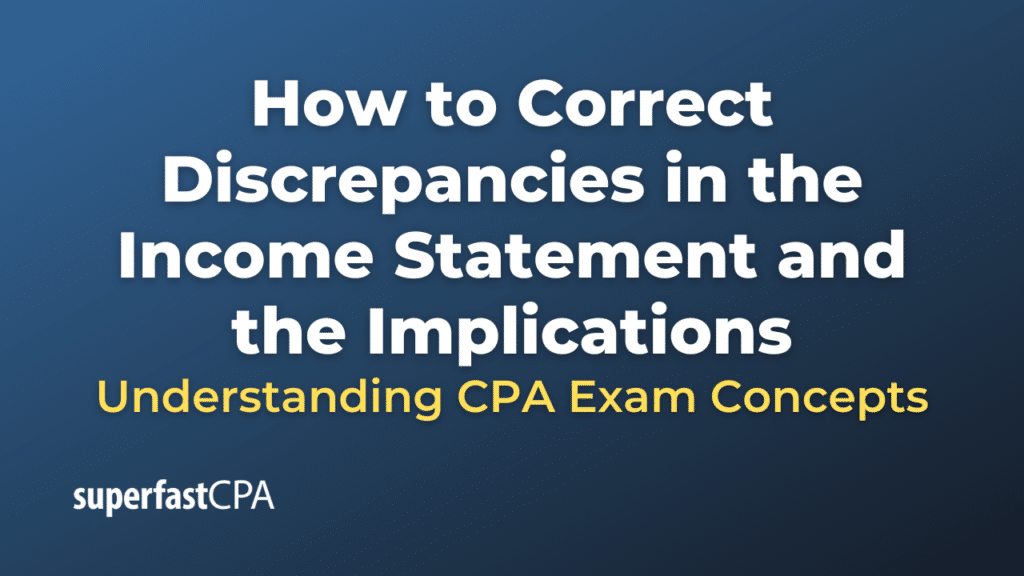Introduction
Overview of the Importance of Accurate Financial Reporting
In this article, we’ll cover how to correct discrepancies in the income statement and the implications. Accurate financial reporting is the cornerstone of trust and transparency in the business world. It provides stakeholders, including investors, creditors, and regulatory bodies, with a clear picture of a company’s financial health and performance. Accurate reports help in making informed decisions, securing investments, and ensuring compliance with legal and regulatory standards. Misreported or inaccurate financial information, on the other hand, can lead to misguided decisions, damage to reputation, legal penalties, and loss of investor confidence. Therefore, maintaining accuracy in financial reporting, especially in the income statement, is crucial for the credibility and long-term success of any organization.
Brief Explanation of Income Statements and Common Discrepancies
An income statement, one of the core financial statements, provides a summary of a company’s revenues, expenses, profits, and losses over a specific period. It is a reflection of the company’s operational performance and is critical for assessing its financial health. Key components include sales revenue, cost of goods sold (COGS), gross profit, operating expenses, and net income.
However, discrepancies in the income statement can occur due to various reasons, such as:
- Revenue Recognition Errors: These occur when revenue is recorded in the wrong accounting period or not in accordance with accounting principles, leading to misstated financial performance.
- Expense Misclassification: This happens when expenses are incorrectly categorized or allocated, affecting the gross and operating margins.
- Accrual vs. Cash Accounting Mistakes: Discrepancies arise when the timing of revenue and expense recognition does not align with the actual cash flow.
- Manual Entry Errors: Simple data entry mistakes or calculation errors can lead to significant discrepancies in the income statement.
Identifying and correcting these discrepancies is vital to ensure the accuracy of financial reporting and maintain the integrity of the financial statements.
Understanding Income Statement Discrepancies
Definition of Income Statement Discrepancies
Income statement discrepancies refer to inaccuracies or inconsistencies in the financial data reported on an income statement. These discrepancies can result from errors, omissions, or misstatements that affect the reported figures of revenue, expenses, and net income. They can distort the financial picture of a company, leading to incorrect assessments of its financial performance and health. Discrepancies may arise due to unintentional mistakes, such as clerical errors, or intentional manipulations, which can involve fraudulent financial reporting. Identifying and correcting these discrepancies is crucial to ensure the reliability and accuracy of financial information provided to stakeholders.
Examples of Common Discrepancies
- Revenue Recognition Errors: These are among the most critical discrepancies and occur when revenue is recognized either before or after the actual transaction meets the criteria for revenue recognition. For example, recording revenue before a service is fully delivered or a product is shipped can inflate income figures, presenting a company as more profitable than it actually is.
- Incorrect Expense Categorization: This involves misclassifying expenses, such as categorizing a capital expenditure as an operating expense, or vice versa. Such misclassifications can impact the operating income and distort the company’s operational efficiency and capital structure in its financial reports.
- Overstated or Understated Expenses: Errors in reporting expenses, like overstating operating costs or understating depreciation, can lead to an inaccurate representation of net income. For instance, understating expenses artificially inflates profits, potentially misleading investors and creditors about the company’s financial health.
- Accrual vs. Cash Accounting Errors: Discrepancies can occur when the accrual basis of accounting is not properly applied, leading to revenues and expenses being recognized at inappropriate times. For example, revenue may be recorded without the corresponding cash receipt, or expenses may be recognized without the related cash payment, thus misaligning the income statement with the actual cash flow.
- Manual Entry and Calculation Mistakes: Even with advanced accounting software, human errors in data entry or calculations can lead to significant discrepancies. Simple mistakes like transposing numbers or misplacing decimal points can have a substantial impact on the financial statements.
Addressing these discrepancies promptly and effectively is essential to maintain the integrity of financial reporting and to uphold stakeholder confidence in the financial information presented by the company.
Detecting Discrepancies
Methods for Identifying Discrepancies
To ensure the accuracy and integrity of the income statement, businesses must employ various methods to detect discrepancies. These methods include:
- Comparative Analysis: This involves comparing current income statement figures with those of previous periods to identify significant variances. Unusual fluctuations or trends can indicate errors or inconsistencies that need further investigation.
- Ratio Analysis: Financial ratios, such as the gross profit margin, operating margin, and net profit margin, are used to assess the company’s financial health. Significant deviations from industry norms or historical trends may signal inaccuracies in the income statement.
- Horizontal and Vertical Analysis: Horizontal analysis compares financial information over multiple periods, while vertical analysis looks at financial statements for a single period to understand the proportion of each line item relative to a base figure, such as revenue. These analyses can help uncover inconsistencies and anomalies.
- Cross-Referencing Financial Statements: The income statement should align with other financial statements, such as the balance sheet and cash flow statement. Discrepancies between these documents can uncover issues in revenue recognition, expense recording, or other financial reporting areas.
- Use of Accounting Software and Tools: Modern accounting software often includes features that automatically detect common discrepancies, such as duplicate entries or balance mismatches, aiding in the early detection of potential issues.
Importance of Regular Financial Review and Audit Procedures
Regular financial reviews and audit procedures are critical in detecting and correcting discrepancies in the income statement. These processes serve several important functions:
- Prevention of Fraud and Error: Regular audits and reviews can deter fraudulent activities and identify errors before they become significant issues, helping to maintain the integrity of financial reporting.
- Compliance with Legal and Regulatory Requirements: Regular audits ensure that a company complies with accounting standards and regulatory requirements, reducing the risk of legal penalties and fines.
- Enhanced Credibility with Stakeholders: Consistent financial review and auditing practices enhance the credibility of the company’s financial reports among investors, creditors, and other stakeholders.
- Strategic Decision Making: Accurate financial data is essential for making informed strategic decisions. Regular reviews help ensure that management has reliable information to guide business strategy and operations.
Implementing systematic and thorough detection methods, coupled with regular financial reviews and audits, forms the backbone of effective financial management and is crucial for maintaining the trust of stakeholders and the overall financial health of a company.
Correcting Discrepancies
Steps to Investigate and Correct Errors
Once discrepancies are detected, timely and accurate correction is crucial to maintain the integrity of the financial statements. The following steps are generally involved in investigating and correcting these errors:
- Identification of the Source: The first step is to trace the discrepancy to its origin. This involves reviewing the transactions and documentation that impacted the reported figures, identifying where the error occurred.
- Analysis of the Error: Once the source is identified, the nature and extent of the error must be analyzed. This analysis helps in understanding whether it was a one-time mistake or part of a recurring issue, and whether it was due to a misunderstanding of accounting principles, a clerical mistake, or potential fraud.
- Adjusting Journal Entries: After thoroughly analyzing the error, the necessary correcting entries should be made. This usually involves posting adjusting journal entries to account for the discrepancy, ensuring that the income statement reflects the corrected figures.
- Review and Verification: Following the adjustments, the corrected entries should be reviewed and verified for accuracy. This review process may involve multiple levels of management and, potentially, external auditors to confirm that the corrections are appropriate and comprehensive.
- Documentation and Reporting: All steps taken to identify and correct the discrepancy should be well-documented. This includes the nature of the error, how it was corrected, and what measures are being taken to prevent similar errors in the future. This documentation is crucial for audit trails and future reference.
Role of Internal Control Systems in Preventing Discrepancies
Internal control systems are essential in preventing discrepancies in the income statement. These systems include policies, procedures, and mechanisms designed to ensure the accuracy and reliability of financial reporting. Key aspects of internal controls in preventing discrepancies include:
- Segregation of Duties: Dividing responsibilities among different individuals or departments reduces the risk of errors and fraud. It ensures that no single individual has control over all aspects of a financial transaction, from initiation to recording and reconciliation.
- Authorization and Approval Processes: Establishing clear protocols for authorizing and approving transactions helps prevent unauthorized or erroneous financial activities that could lead to discrepancies.
- Reconciliation Procedures: Regularly reconciling account balances with underlying documentation and transaction records helps identify and rectify discrepancies at an early stage.
- Access Controls: Limiting access to financial systems and data to authorized personnel minimizes the risk of unauthorized transactions and data tampering.
- Regular Training and Education: Ensuring that financial and accounting staff are well-trained and up-to-date with accounting standards, company policies, and best practices is vital in preventing errors and discrepancies.
By implementing robust internal control systems and following a systematic approach to investigating and correcting discrepancies, companies can significantly enhance the accuracy and reliability of their financial reporting.
Legal and Ethical Considerations
Consequences of Intentional Discrepancies
Intentional discrepancies in the income statement, such as fraud or misrepresentation, carry serious legal and ethical implications. These actions can lead to:
- Legal Penalties: Companies and individuals involved in intentional financial misreporting can face civil and criminal charges, resulting in hefty fines, penalties, and even imprisonment.
- Loss of Trust and Reputation: Engaging in fraudulent activities can severely damage an organization’s reputation, leading to a loss of trust among investors, customers, and partners. Restoring credibility can be a long and challenging process.
- Financial Losses: Misrepresentation of financial information can lead to poor business decisions, loss of investment, and in severe cases, bankruptcy or business failure.
- Operational Disruptions: Legal proceedings and the fallout from fraud can lead to significant operational disruptions, including changes in management, loss of employees, and strained relationships with creditors and suppliers.
Regulatory Framework and Compliance Requirements
To prevent discrepancies and ensure the accuracy of financial reporting, businesses must adhere to established regulatory frameworks and compliance requirements, such as:
- Generally Accepted Accounting Principles (GAAP): In the United States, GAAP sets the standard for accounting practices, including how income statements should be prepared and presented. Following GAAP helps ensure transparency and consistency in financial reporting.
- International Financial Reporting Standards (IFRS): For companies operating internationally, IFRS provides a common accounting language to ensure consistency and comparability of financial statements across borders.
- Sarbanes-Oxley Act (SOX): In response to major corporate and accounting scandals, SOX was enacted to protect investors by improving the accuracy and reliability of corporate disclosures made pursuant to securities laws, and for other purposes.
- Auditing Standards: Regular audits by independent, qualified auditors are required to ensure that financial statements accurately represent a company’s financial position. These audits must adhere to recognized standards such as those set by the Public Company Accounting Oversight Board (PCAOB) in the U.S. or the International Auditing and Assurance Standards Board (IAASB) globally.
Compliance with these frameworks and standards is not just a legal requirement but also a crucial component of ethical corporate governance. Companies must continuously monitor and update their accounting practices to stay compliant with evolving standards and regulations, thereby safeguarding against the risks associated with financial discrepancies.
Implications of Discrepancies
Impact on Financial Analysis and Business Decisions
Discrepancies in the income statement can significantly distort the financial analysis and subsequent business decisions. These implications include:
- Misguided Strategies: Executives rely on financial statements to inform their strategic decisions. If income is overstated, a company might undertake unnecessary expansions or investments, whereas understated income might lead to missed opportunities for growth.
- Budgeting and Forecasting Issues: Inaccurate financial data can lead to flawed budgeting and forecasting, affecting a company’s ability to plan and allocate resources effectively.
- Performance Evaluation: Discrepancies can lead to incorrect assessments of a company’s financial health and operational efficiency, impacting evaluations of management performance and strategic initiatives.
Effects on Company Reputation, Investor Trust, and Market Value
The repercussions of income statement discrepancies extend beyond internal decision-making to affect external perceptions and valuations of the company:
- Damaged Reputation: Public disclosure of financial discrepancies can lead to a damaged reputation, as stakeholders question the reliability and integrity of the company’s financial reporting.
- Eroded Investor Trust: Investors depend on accurate financial statements to make informed investment decisions. Discrepancies can erode trust, leading to a withdrawal of current and potential investment.
- Market Value Fluctuation: The stock market reacts negatively to financial discrepancies, often resulting in a decline in share price. This decrease in market value can affect a company’s ability to raise capital, negotiate loans, and maintain shareholder equity.
The implications of discrepancies in the income statement are far-reaching, affecting not just the internal management of a company but also its external standing and relationships with stakeholders. Ensuring accuracy and transparency in financial reporting is therefore paramount to maintaining a company’s credibility, operational stability, and financial health.
Case Studies
Real-world Examples of Income Statement Discrepancies and Their Resolution
- Enron Corporation: Perhaps one of the most infamous cases of financial statement fraud, Enron’s downfall in the early 2000s was due to the concealment of massive debts and inflated profits. The scandal led to the bankruptcy of the company and the dissolution of Arthur Andersen, one of the five largest audit and accountancy partnerships in the world. The resolution involved significant legal actions, with several company executives being convicted of fraud, conspiracy, and insider trading.
- Xerox Corporation: In the early 2000s, Xerox faced allegations of fraudulent earnings manipulation by accelerating revenue recognition. The company had to restate its financials, reflecting billions of dollars in adjustments. The resolution included a settlement with the Securities and Exchange Commission (SEC) and the implementation of new internal controls and accounting procedures.
- Tesco: The British supermarket chain Tesco admitted in 2014 to overstating its profits by £263 million due to premature recognition of revenue and delayed acknowledgment of costs. The scandal led to the resignation of several senior executives and a comprehensive internal investigation. Tesco settled with regulators and investors and undertook significant corporate governance reforms.
Lessons Learned from Past Incidents
- Importance of Ethical Practices: The cases underscore the critical need for ethical behavior and integrity in financial reporting. Companies must foster a culture of honesty and transparency to prevent fraudulent activities.
- Robust Internal Controls: These incidents highlight the necessity for strong internal controls and governance frameworks to detect and prevent accounting irregularities.
- Audit and Oversight Function: The role of external auditors and oversight bodies is crucial in verifying the accuracy of financial reports and ensuring compliance with regulatory standards.
- Transparency with Stakeholders: Maintaining open communication with stakeholders about financial performance and challenges is vital for building and sustaining trust.
- Regulatory Compliance: Adherence to accounting standards and regulations is essential. These cases led to stricter regulatory requirements, such as the Sarbanes-Oxley Act, to improve financial transparency and accountability.
The resolution of income statement discrepancies often requires not only rectifying the financial records but also implementing systemic changes to prevent future occurrences. Learning from past incidents, companies can enhance their financial reporting processes, strengthen internal controls, and promote a culture of integrity and transparency.
Best Practices for Maintaining Accurate Financial Records
Strategies for Ensuring Data Accuracy and Integrity
Maintaining accurate financial records is paramount for any business. Here are some strategies to ensure data accuracy and integrity:
- Automated Accounting Systems: Implementing automated accounting software can reduce human errors in data entry and calculations. These systems can also flag inconsistencies and discrepancies for review, enhancing the accuracy of financial records.
- Regular Audits and Reviews: Conducting regular internal and external audits helps in verifying the accuracy of financial information and ensuring compliance with accounting standards and regulations. These audits can identify potential discrepancies and areas for improvement in financial reporting processes.
- Reconciliation Procedures: Regularly reconciling bank statements, invoices, and receipts with ledger entries ensures that all financial transactions are accurately recorded and accounted for.
- Segregation of Duties: Splitting responsibilities for financial reporting and review among different employees or departments minimizes the risk of errors and fraud. This approach ensures that no single individual has control over all aspects of financial transactions, from initiation to recording and review.
- Use of Standardized Procedures: Developing and adhering to standardized accounting procedures can help maintain consistency and accuracy in financial reporting. This includes following established protocols for recording transactions, conducting inventory counts, and recognizing revenue and expenses.
Training and Education for Financial Personnel
- Continuous Training Programs: Regular training sessions for financial personnel on the latest accounting standards, technologies, and best practices are crucial. This ensures that they are up-to-date with current regulations and proficient in using accounting software and systems.
- Professional Development: Encouraging ongoing professional education and certification for accounting staff, such as CPA (Certified Public Accountant) or CMA (Certified Management Accountant) designations, can enhance their expertise and commitment to financial accuracy.
- Ethics Training: Incorporating ethics training into the professional development of financial personnel emphasizes the importance of integrity and transparency in financial reporting.
- Cross-Training: This allows employees to understand multiple aspects of the financial reporting process, reducing dependency on single individuals and ensuring that more than one person is capable of performing critical financial tasks.
Implementing these best practices can significantly reduce the risk of discrepancies in financial records, thereby enhancing the reliability and accuracy of financial reporting. Regular training and the use of technology, along with strong internal controls and audits, form the foundation of effective financial management.
Conclusion
Recap of the Significance of Accurate Income Statement Reporting
Accurate income statement reporting is fundamental to the financial transparency and accountability of a company. It provides stakeholders with a clear view of the company’s financial performance and health, influencing decisions made by investors, creditors, and management. The integrity of the income statement affects a company’s reputation, its access to capital, and its ability to compete and grow. Discrepancies in financial reporting can lead to misguided business decisions, legal repercussions, and loss of stakeholder trust, underscoring the importance of accuracy in financial statements.
Final Thoughts on the Continuous Effort Required to Maintain Financial Accuracy and Transparency
Maintaining financial accuracy and transparency is not a one-time task but a continuous effort that requires commitment from all levels of an organization. It involves the implementation of robust internal control systems, regular audits and reviews, adherence to legal and regulatory standards, and a culture of honesty and ethical behavior. Education and training for financial personnel play a crucial role in ensuring that those responsible for financial reporting are competent, ethical, and aware of current accounting standards and practices.
In a rapidly evolving business environment, organizations must stay vigilant in monitoring their financial reporting processes and be proactive in identifying and correcting discrepancies. The use of advanced technologies and automated systems can greatly aid in this endeavor, providing real-time insights and analytics to detect and address potential issues promptly.
In conclusion, accurate income statement reporting is essential for the sustainable success of any organization. It demands a continuous commitment to meticulous financial management, ethical conduct, and a proactive approach to identifying and addressing discrepancies. By prioritizing financial accuracy and transparency, companies can build and maintain the trust of their stakeholders, ensuring their long-term viability and growth in the competitive business landscape.
References
- Accounting Textbooks and Journals: These provide foundational knowledge and detailed explanations of accounting principles and practices. Examples include:
- Kieso, D. E., Weygandt, J. J., & Warfield, T. D. (Latest Edition). Intermediate Accounting. John Wiley & Sons.
- Smith, J. (Year). “Income Statement Errors and Their Implications.” Journal of Accounting Research.
- Professional Standards and Guidelines:
- Financial Accounting Standards Board (FASB). (Latest Edition). Statement of Financial Accounting Standards (SFAS).
- International Accounting Standards Board (IASB). (Latest Edition). International Financial Reporting Standards (IFRS).
- Regulatory Frameworks:
- U.S. Securities and Exchange Commission (SEC). “Regulation S-X: Form and Content of and Requirements for Financial Statements.”
- Sarbanes-Oxley Act of 2002.
- Case Studies and Real-world Examples:
- Healy, P. M., & Palepu, K. G. (Year). “The Fall of Enron.” Journal of Economic Perspectives.
- Jones, S. (Year). “Tesco’s Accounting Scandal: A Case Study.” Corporate Governance.
- Online Resources and Databases:
- Electronic Data Gathering, Analysis, and Retrieval system (EDGAR) for accessing public company filings.
- Academic databases like Google Scholar, JSTOR, or SSRN for scholarly articles on financial discrepancies and accounting fraud.
- Industry Reports and Market Analysis:
- PricewaterhouseCoopers (PwC), Deloitte, Ernst & Young (EY), and KPMG’s annual reports on global accounting trends and issues.
- Ethics and Compliance Resources:
- Institute of Internal Auditors (IIA). “Global Internal Audit Common Body of Knowledge (CBOK).”
- Ethics and Compliance Initiative (ECI). “Global Business Ethics Survey (GBES).”













